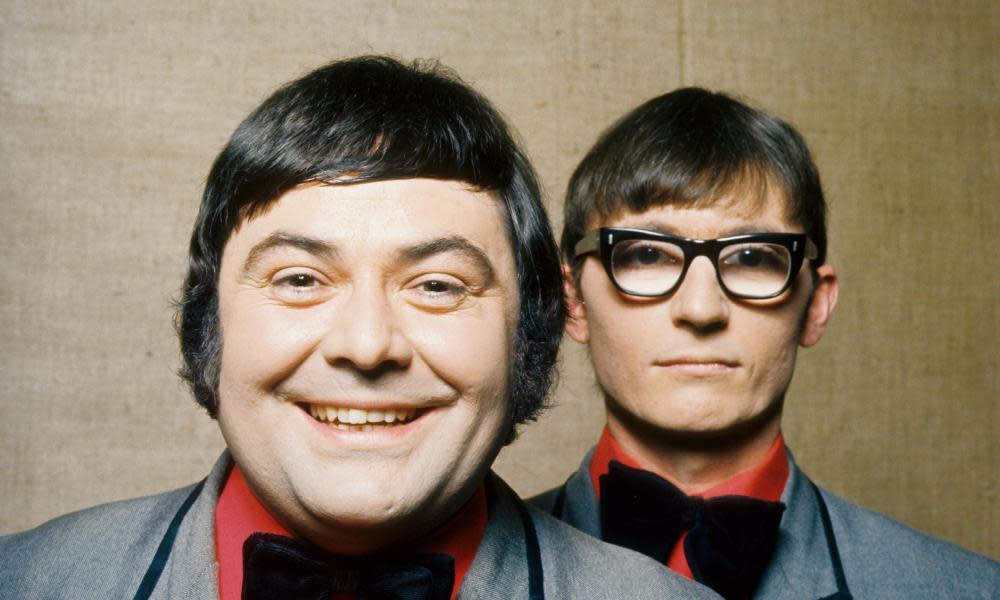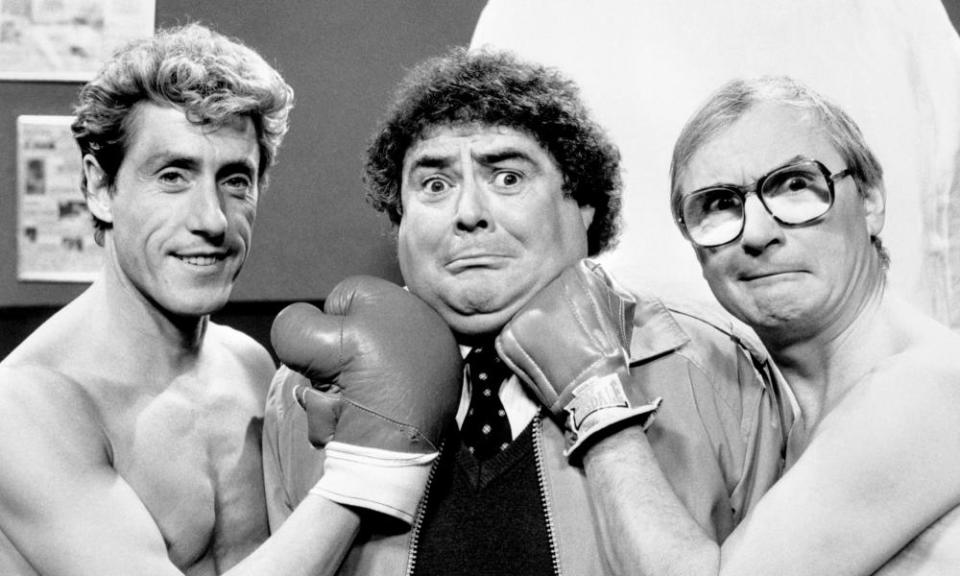Large by name, large by nature: Eddie was the big man of 80s British TV comedy

Would a comedy double act called McGinnis and Mead ever have come to be seen as the natural successors to Eric Morecambe and Ernie Wise? That remains a counter-historical imponderable. But, when Edward Hugh McGinnis, who has died aged 78, changed his name to Eddie Large and teamed up with Cyril John Mead, who called himself Syd Little, the duo Little and Large did take the place of Morecambe and Wise – in terms at least of BBC One scheduling prominence from 1978 to 1991.
Large had mostly retired from the showbiz frontline in 2003, following a heart transplant. The immunosuppressant drugs necessary after such an operation put him in one of the highest-risk groups for the Covid-19 virus.
Related: Eddie Large obituary
From Laurel and Hardy and Abbott and Costello to Fry and Laurie, comedy double acts have often paired performers of sharply contrasting height and/or weight. Little and Large made this aspect literal, their adopted comedy personas reflecting Mead’s slight, thin build and McGinnis’s generous girth.

Detractors might say that the literalness of their stage names was often matched by the obviousness of their comedy involving foreign accents or underdressed women. It is only fair to note, though, that they attracted 15 million viewers a week at their peak, and were known on the pier and panto circuit for their ability to draw loud and raucous laughter, especially from older audiences.
Many comedy duos end in hostility – and McGinnis and Mead were estranged for many years before a couple of recent TV guest appearances. But, more unusually, Little and Large began at loggerheads. They met at a pub in Wythenshawe, Lancashire, when McGinnis heckled Mead, who was at that time a singer-guitarist. The catcalls from the audience helped persuade the performer to abandon his music but, over a drink, the men concocted the act that became Little and Large.

Under a name that baldly advertised their differing frames, the act was also unusually blunt in its division between comedian and straight man. Large got all of the gags and most of the action while Little’s status as stooge involved a contribution so reduced that a running gag would involve Eddie checking Syd was still conscious. Large’s jokey nickname of “Supersonic” for his partner – a reference from the era of high-speed Concorde air travel – also played off this extravagant passivity. Deliberately or not, the names Large and Little also reflected their contribution to the act.
British television includes, three decades apart, two sets of performers who achieved fame through TV talent shows. Since 2004, the second set is those, such as Alexandra Burke and Susan Boyle, who emerged through The X Factor or Britain’s Got Talent. The earlier class comprises turns who, between 1964 and 1978, emerged through peak-time auditions on ITV’s New Faces and Opportunity Knocks. Among these were Les Dawson and Freddie Starr, who turned success on Opportunity Knocks into enduring TV careers – as did Little and Large, after winning the 1971 series.
Although Large came from Glasgow, his accent had gradually levelled down to that of the Blackpool-born Little, perhaps encouraged by an apprenticeship on the working-men’s club circuit in the north of England, so that they came to be seen as a northern duo. This may have given them an edge when, in 1977, the BBC was forced to find substitutes for the most famous Lancastrian double-act in television. Eric Morecambe and Ernie Wise had left the corporation, having been offered a big money deal at ITV.
Eddie Braben, the main writer for Morecambe and Wise, remained under contract to the BBC and was redeployed as main scriptwriter on The Little & Large Show, which premiered with a special on the May bank holiday weekend in 1978.

Braben was a master gag-writer and Eric and Ernie, without him, seemed less good on ITV. He made Little and Large seem better than they had previously been, but the key to his work with Morecambe and Wise had been creating a carefully defined comic character for each; with a double act that essentially revolved around Large’s confidence and Little’s diffidence, it was impossible to create a similar dynamic. Whereas Morecambe could collapse an audience with a single glance or intonation, and Wise was an accomplished singer and dancer, Large relied on a limited range of impressions (often of vintage cartoon characters), while Little’s shtick depended on not doing very much at all.
They did, though, get much closer to the Eric and Ernie mantle than their ITV rivals in the 1980s: another Lancashire duo, Cannon and Ball (the stage names of Robert Harper and Thomas Derbyshire.)
In recent years, McGinnis’s health difficulties and some family problems for Mead encouraged retrospective audience warmth towards Little and Large, on which they were able to draw by overcoming their post-TV falling-out sufficiently to appear together on Ant & Dec’s Saturday Takeaway in 2018 and Pointless Celebrities last year.
At their height, Large, with Little, made a lot of money and a lot of people laugh. They turned out not to be the new Morecambe & Wise. But then, whoever was or will be?

 Yahoo News
Yahoo News 
